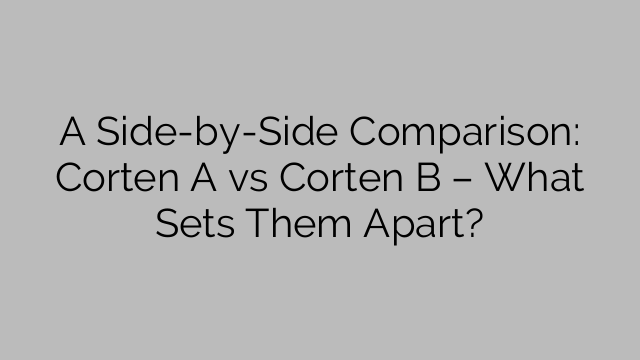When it comes to weathering steel, Corten is undoubtedly one of the most popular names in the industry. Its unique rust-like appearance, coupled with its exceptional durability, makes it a top choice for architects, designers, and manufacturers alike. Two of its most commonly used variations are Corten A and Corten B. While they may seem similar at first glance, there are some key differences that set them apart.
Chemical Composition
One of the fundamental differences between Corten A and Corten B lies in their chemical compositions. Corten A primarily contains iron, copper, chromium, and nickel, whereas Corten B consists of iron, copper, chromium, and phosphorus. The inclusion of phosphorus in Corten B makes it more suitable for applications requiring superior weather resistance.
Mechanical Properties
In terms of mechanical properties, Corten A and Corten B also display variations. Corten A has a higher tensile strength and yield strength compared to Corten B. This implies that Corten A can withstand higher stresses and is more resistant to external forces. On the other hand, Corten B offers a slightly higher elongation, making it more ductile and easy to work with during fabrication processes.
Applications
Both Corten A and Corten B find widespread application in architectural and structural projects due to their exceptional weathering capabilities. However, their specific properties lend themselves to different uses. Corten A is commonly used in outdoor structures, such as bridges, facades, and sculptures, that require high tensile strength and structural stability. Corten B, with its improved phosphorus content, is often favored for applications in harsh environments, including marine and industrial settings.
Weathering Process
One of the main reasons why Corten steel is so popular is its unique ability to develop a protective layer of rust-like appearance, known as the patina, over time. This patina acts as a corrosion barrier, protecting the steel from further degradation. Both Corten A and Corten B undergo this weathering process. However, due to its higher phosphorus content, Corten B develops the protective layer at a slightly faster rate compared to Corten A.
Price Considerations
Cost is often a significant aspect to consider when choosing between Corten A and Corten B. Generally, Corten B is slightly more expensive than Corten A due to its enhanced properties. However, the price difference may vary depending on the specific supplier and market conditions.
結論
In conclusion, while Corten A and Corten B share many similarities, it is essential to understand the differences that set them apart. Corten A offers higher tensile and yield strength, making it suitable for structural applications, while Corten B provides better weather resistance and ductility, making it ideal for harsh environments. It is crucial to consider the specific requirements of your project to determine which variation of Corten steel suits your needs best.
[ad_2]

